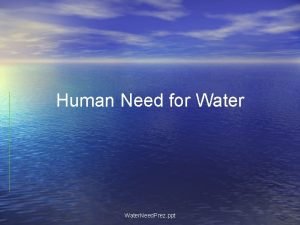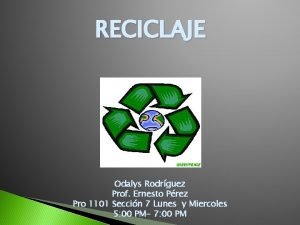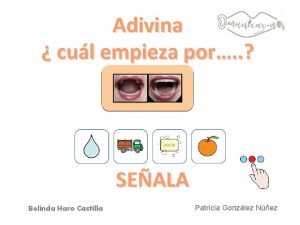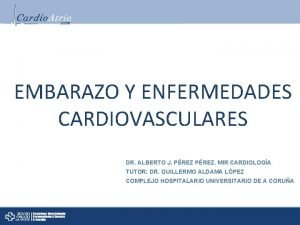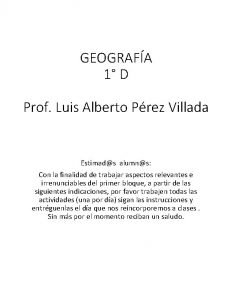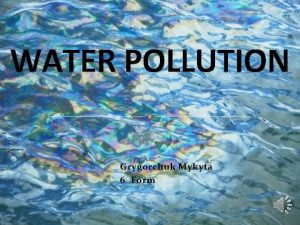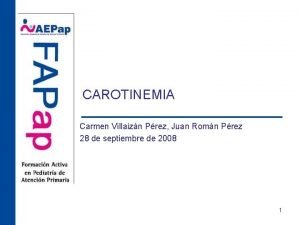Human Need for Water Need Prez ppt Form































- Slides: 31

Human Need for Water. Need. Prez. ppt

Form Teams • Form a line across the room shortest to tallest. • Count off by twos. • Sit together with the classmates that got the • • • same number as you did. Have a piece of paper and pencil ready to take some notes. Be prepared to compete in “Water Jeopardy” The winning team will be the one that has the most points at the end of the game!

The Rules • Listen Carefully….

Get Ready to Play. . . Water Jeopardy!

Rules & Format for Answers • All facts must be presented with three sources of information confirming the answer. – Question – Answer • Source (MLA or APA, alphabetical order) • Source • All numerical answers must be presented with calculations. – Question – Answer • Formula • Calculations

Question #1 • What is the chemical formula of water? • Have your mathematician document the • • • density of water, the weight of water per cubic foot, gallon, liter, quart, cup. Have your scientist model a water molecule out of clay. Have your researcher document sources. Return with answers, source(s) and clay model.

Answer #1 • H 2 O Oxygen Hydrogen

Question #2 • What % of the Earth is made up of water? • What % of water is Salt, Fresh, and • • Frozen? Have your scientist locate answers, researcher document sources and mathematician sketch create two pie charts for the information. Return with a labeled pie charts and source(s).

Answer #2 • The Earth is made up of • • • approximately 70% water. 97% of that water is salt water. Very little is fresh water that we use to drink, cook and clean. 2% of water is frozen. 1% of water is fresh water.

Question #4 • What % of our body is made up of • • water? Have your scientist help locate information, researcher document sources and mathematician sketch body outline and shade in the appropriate percentage. Bring back the answer in the form of the labeled sketch with the source(s).

Answer #4 • The human body is • made up of approximately 60 -70% water. One medical source documents that men have 60% and women have 50% water.

Question #5 • What percentage of blood is water? • Have your scientist help locate information, researcher document sources, and mathematician generate an illustration to depict the water make-up of blood.

Answer #5 • 90% of 55% which is 49. 5% • When spun in a centrifuge, the cells and cell • fragments of blood are separated from the liquid intercellular matrix. Because the formed elements are heavier than the liquid matrix, they are packed in the bottom of the tube by the centrifugal force. The light yellow colored liquid on the top is the plasma, which accounts for about 55 percent of the blood volume and red blood cells is called the hematocrit, or packed cell volume (PCV). The white blood cells and platelets form a thin white layer, called the "buffy coat, " between plasma and red blood cells. Plasma is the watery fluid portion of blood (90 percent water) in which the corpuscular elements are suspended. It transports nutrients as well as wastes throughout the body. Various compounds, including proteins, electrolytes, carbohydrates, minerals, and fats, are dissolved in it.

Answer #5 • 92% of 54% is 49. 68%

Bonus • Using the following site, calculate how • • much water your team should drink a day. http: //nutrition. about. com/library/blwatercal culator. htm First team with an answer gains an internet use!

Question #6 • Identify two main functions of water in the body’s metabolic process. • Identify up to four other bodily functions that water has for one bonus point each.

Answer #6 • Water has 2 main functions in the metabolic process – It delivers oxygen and nutrients to different parts of the body. – It removes toxins and waste from the body. http: //www. be-withyou. com/dew/Water. And. Our. Body. html

Answer #6 • Water also has other functions: – Regulates body temperature through perspiration. – Reduces friction between joints and facilitates movement. – Acts as a cushion between organs in order to protect them. – Facilitates normal functions of body processes.

Question #7 • What three ways does the body lose • • • water? How much water does a body lose in one day from normal activity? How many days can you survive without water? How much water loss would cause death?

Answer #7 • A person can go without food for several weeks in • necessary, but without water life cannot last more than a few days. The human body is 60 -70 % water. We take in water with food and drink, and lose it in urine, in sweat, and in our breath (as water vapor). A person loses 2 to 3 quarts (1. 89 -2. 83 l) of water every day as a result of their normal body functions. • This much loss means if a person doesn't get any fluids for about three days, they will die. • 6 -9 quarts (5. 678 -8. 517 l) of water loss would cause death.

Question #8 • Recall how much water the average person loses in • • one day through their urine, sweat, and normal breathing. Have your mathematician create a graph to identify what percentage of overall water loss occurs when: – Thirst is perceived. – Strength and endurance decrease. – Delirium and blurred vision become a problem and you can not move. – A person dies. Calculate the amount of water loss for each based on the amount of water lost per day.

Answer #8 • In one day the average person loses between 2 to 3 quarts of water through their urine, sweat, and normal breathing. If a person doesn't replace that lost water, then dehydration begins to occur. – At 1 -2% dehydration, thirst is perceived. (. 6 -. 9 quarts) – At 5% dehydration, a person becomes hot and tired, and strength and endurance decrease. (1. 5 -2. 25 quarts) – At 10% dehydration, delirium and blurred vision become a problem and you can not move. (3 -4. 5 quarts) – At 12 -20% dehydration, a person dies. (6 -9 quarts)

Answer #8

So? • Most people have never thought about the above because they have NEVER been personally confronted with an extended shortage of fresh safe drinking water at any time in their lives. • In many other countries, they think about this every day. A shortage of fresh safe drinking water is a daily problem.

Dehydration during Competition • Athlete – – – – – Lightweight Boxer Baseball Player 200 -M Sprinter Shot-Putter Race Walker Sprinter/long Jump Marathoner Triathlete Tennis Player • Sweat Rate(Qts/Hr) – – – – – . 85 1. 16 1. 19 1. 27 1. 48 1. 51 1. 6 5. 92

Note! • Keep in mind that these numbers only • represent what the human body needs on the inside. We haven’t even thought about washing your hands, brushing your teeth or bathing.

Other Water Facts • 1. 2 billion people lack access to safe water, roughly one-sixth of the • • world's population and 2. 4 billion or 40 percent of the world's people lack access to adequate sanitation services. Some 6, 000 children die every day from diseases associated with unsafe water and poor sanitation and hygiene. Unsafe water and sanitation cause an estimated 80 percent of all diseases in the developing world. Women and girls tend to suffer the most as a result of the lack of sanitation facilities. One flush of a Western toilet uses as much water as the average person in the developing world uses for a whole day's washing, drinking, cleaning and cooking.

Continued. . . • Water use has grown at twice the rate of population during the past • • century. The Middle East, North Africa and South Asia are chronically short of water. In developing countries, as much as 90 percent of waste water is discharged without treatment. Over pumping groundwater for drinking water and irrigation has caused water levels to decline by tens of meters in many regions, forcing people to use low-quality water for drinking. Losses of water through leakage, illegal hook-ups and waste amount to about 50 percent of water for drinking and 60 percent of water for irrigation in developing countries. Floods affected more than 75 percent of all people impacted by natural disasters during the 1990 s and caused over 33 percent of the total estimated costs of natural disasters.

Water Consumption • A Masai person in Kenya will use 10 litres (3 gallons) of water per day • An average Canadian uses 326 litres (86 gallons) per • • day An American person in Los Angeles will use 500 litres (132 gallons) of water per day An average person in India uses 53 litres (14 gallons) per day An average person in Japan uses 292 litres (77 gallons) per day An average person in Switzerland uses 405 litres (107 gallons) per day

Water Usage • It takes 2072 gallons of water to make four car tires • It takes 24 gallons of water to produce 1 pound of • • • plastic It takes 1851 gallons of water to refine one barrel of crude oil It takes 60 gallons of water to produce 1 pound of potatoes It takes 108 gallons of water to produce 1 pound of wheat It takes 240 gallons of water to produce 1 pound of soybeans It takes 12, 009 gallons of water to produce 1 pound of beef

Sources • Diamond Energy Water. The close relationship • • between Water & Our Body. 19 April 2008 <http: //www. be-withyou. com/dew/Water. And. Our. Body. html>. We Rise. Water Facts. Allabout_facts. 15 May 2008 <www. werise. us/allabout_facts. html> “Olympic Science: The Hydration Rate. ” Popular Mechanics. August 2008. 68.
 Ppt
Ppt Water and water and water water
Water and water and water water Gabriel duu prez
Gabriel duu prez Introduccion del reciclaje
Introduccion del reciclaje Salud y temperancia
Salud y temperancia Prez blackmon
Prez blackmon Beatriz mercado
Beatriz mercado E prez
E prez E prez
E prez Dayana prez sosa
Dayana prez sosa Biografia de jesus adrian romero
Biografia de jesus adrian romero Electrotropismo
Electrotropismo Daniel prez
Daniel prez Dayana prez
Dayana prez Dr prez
Dr prez Prez significado
Prez significado Fspos
Fspos Typiska drag för en novell
Typiska drag för en novell Nationell inriktning för artificiell intelligens
Nationell inriktning för artificiell intelligens Vad står k.r.å.k.a.n för
Vad står k.r.å.k.a.n för Shingelfrisyren
Shingelfrisyren En lathund för arbete med kontinuitetshantering
En lathund för arbete med kontinuitetshantering Adressändring ideell förening
Adressändring ideell förening Personlig tidbok
Personlig tidbok A gastrica
A gastrica Densitet vatten
Densitet vatten Datorkunskap för nybörjare
Datorkunskap för nybörjare Stig kerman
Stig kerman Att skriva debattartikel
Att skriva debattartikel Autokratiskt ledarskap
Autokratiskt ledarskap Nyckelkompetenser för livslångt lärande
Nyckelkompetenser för livslångt lärande Påbyggnader för flakfordon
Påbyggnader för flakfordon
